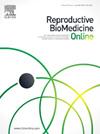THE DOUBLE-STRAND BREAK PROTEINS NBS1, KU70, KU80, RAD51 AND BRCA1 EXHIBIT SIGNIFICANT ALTERATIONS IN NON-OBSTRUCTIVE AZOOSPERMIC INFERTILE MEN HAVING PRIMARY SPERMATOCYTE AND ROUND SPERMATID ARREST
IF 3.7
2区 医学
Q1 OBSTETRICS & GYNECOLOGY
引用次数: 0
Abstract
Objective
Azoospermia, characterized by the absence of sperm in ejaculate, affects about 1% of general population. Non-obstructive azoospermia (NOA), which constitutes 60% of azoospermic infertility cases, remains poorly understood at the molecular level. DNA double-strand breaks (DSBs) being formed for different reasons such as DNA replication, DNA lesions, crossing-over and genotoxic agents are repaired timely and correctly to maintain genome integrity. In response to sensing DSBs, the histone variant H2AX is phosphorylated at serine 139 by ATM kinase to form γH2AX. Thus, the main DSB repair pathways such as homologous recombination (HR) and canonical non-homologous end joining (cNHEJ) are activated. While the KU70 and KU80 proteins play key roles in cNHEJ repair, the NBS1, RAD51, and BRCA1 proteins contribute HR-based repair. Importantly, absence or expressional changes in these proteins is found to be associated with male infertility development. Our study aims to elucidate the role of γH2AX, KU70, KU80, NBS1, RAD51, and BRCA1 proteins in losing fertility in NOA patients.
Materials and Methods
After taking ethical committee approval (protocol no. 13.05.2020/KAEK-345), we utilized previously collected testicular sperm extraction (TESE) samples in this study. We categorized the TESE samples according their histopathological status into four groups: hypospermatogenesis (n=6), primary spermatocyte arrest (n=6), round spermatid arrest (n=6), and Sertoli cell-only syndrome (n=6). Additionally, a control group having normal spermatogenesis (n=6) was created. With immunohistochemistry, we stained all the aforementioned proteins and analyzed their expression patterns with the ImageJ software. The resulting data were then evaluated using the non-parametric Mann-Whitney U test.
Results
The relative levels of γH2AX were significantly higher in primary spermatocyte and round spermatid arrest groups when compared to the control group (P<0.01). The NBS1 protein was mainly localized in the nuclei of the spermatogenic cells, and its levels significantly reduced in patients with primary spermatocyte and round spermatid arrest groups (P<0.05). Additionally, significant reductions in the KU70 (P<0.01), KU80 (P<0.01) and RAD51 (P<0.05) proteins were observed in the total and seminiferous tubules of the primary spermatocyte and round spermatid arrest groups when compared with the control group. In contrast, BRCA1 protein levels significantly increased in the hypospermatogenesis, primary spermatocyte arrest and round spermatid arrest groups compared to the control group (P<0.01).
Conclusions
The significant reductions in NBS1, KU70, KU80, and RAD51 proteins, along with increasing BRCA1 levels may be associated with developing spermatogenic arrest in NOA patients. Further studies are required to elucidate the mechanistic effects of changed expression of these proteins in cNHEJ and HR repairs in primary spermatocytes and round spermatids.
求助全文
约1分钟内获得全文
求助全文
来源期刊

Reproductive biomedicine online
医学-妇产科学
CiteScore
7.20
自引率
7.50%
发文量
391
审稿时长
50 days
期刊介绍:
Reproductive BioMedicine Online covers the formation, growth and differentiation of the human embryo. It is intended to bring to public attention new research on biological and clinical research on human reproduction and the human embryo including relevant studies on animals. It is published by a group of scientists and clinicians working in these fields of study. Its audience comprises researchers, clinicians, practitioners, academics and patients.
Context:
The period of human embryonic growth covered is between the formation of the primordial germ cells in the fetus until mid-pregnancy. High quality research on lower animals is included if it helps to clarify the human situation. Studies progressing to birth and later are published if they have a direct bearing on events in the earlier stages of pregnancy.
 求助内容:
求助内容: 应助结果提醒方式:
应助结果提醒方式:


